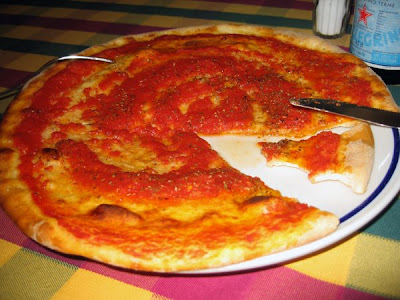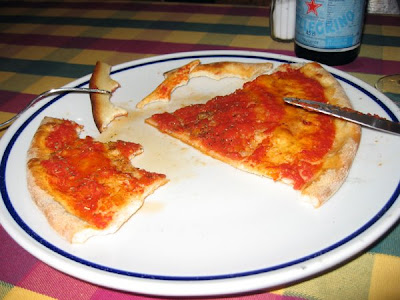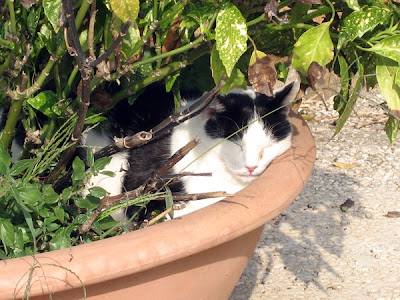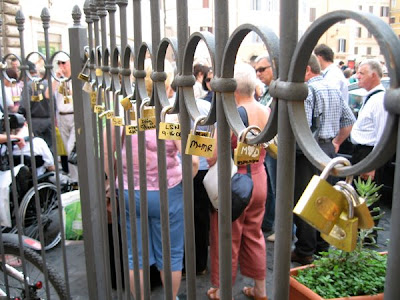 Tonight is the Eve of the Feast of All Hallows - Halloween. It still isn't a big thing in Italy, unlike the British Isles and North America it is simply what the name originally meant: the Night before the Feast of All Saints. Tomorrow will be the big day - Ognissanti is the day for families to come together and remember loved ones who have died and to make a special trip to the cemetery.
Tonight is the Eve of the Feast of All Hallows - Halloween. It still isn't a big thing in Italy, unlike the British Isles and North America it is simply what the name originally meant: the Night before the Feast of All Saints. Tomorrow will be the big day - Ognissanti is the day for families to come together and remember loved ones who have died and to make a special trip to the cemetery.  I've noticed that pastry shop windows are starting to go all the way with pumpkins, witches, skeletons but candy for Halloween isn't all that popular - a torta di cioccolata, well that's another story. As for pumpkin carving that probably strikes most Italians as the waste of a good filling for ravioli. But the young students at the school where my friend Larry teaches carved jack o'lanterns for a good cause. Larry mentioned on Amoroma last week that for €10 a family could take a pumpkin and participate in a pumpkin carving contest. The proceeds went to the the Haiti Cherie fund to feed street children in Port-au-Prince. There are some really fine and frightening examples of the pumpkin carvers art on display - I particularly love Carmen Miranda.
I've noticed that pastry shop windows are starting to go all the way with pumpkins, witches, skeletons but candy for Halloween isn't all that popular - a torta di cioccolata, well that's another story. As for pumpkin carving that probably strikes most Italians as the waste of a good filling for ravioli. But the young students at the school where my friend Larry teaches carved jack o'lanterns for a good cause. Larry mentioned on Amoroma last week that for €10 a family could take a pumpkin and participate in a pumpkin carving contest. The proceeds went to the the Haiti Cherie fund to feed street children in Port-au-Prince. There are some really fine and frightening examples of the pumpkin carvers art on display - I particularly love Carmen Miranda. Trick or treating isn't a big thing and given that most people live in apartments probably not all that practical. And children here don costumes more for Carnivale in March than for Halloween. Which brings me to the pictures accompanying this post. Those would be of my friend Marc B. and members of his wild trick or treating crew. Every year the family go out - en masse, if 4 can be considered a masse - to trick or treat in their neighbourhood. I recall a Star Wars theme one year and it appears that this year has taken on a decided Tim Burton tone. That would be Marc as the Mayor of Halloweentown, Justin as Jack Skellington, Erika as Sally and out of camera range putting the finishing touches on Erika's costume Christiane who I understand will be a witch for the festivities.
Trick or treating isn't a big thing and given that most people live in apartments probably not all that practical. And children here don costumes more for Carnivale in March than for Halloween. Which brings me to the pictures accompanying this post. Those would be of my friend Marc B. and members of his wild trick or treating crew. Every year the family go out - en masse, if 4 can be considered a masse - to trick or treat in their neighbourhood. I recall a Star Wars theme one year and it appears that this year has taken on a decided Tim Burton tone. That would be Marc as the Mayor of Halloweentown, Justin as Jack Skellington, Erika as Sally and out of camera range putting the finishing touches on Erika's costume Christiane who I understand will be a witch for the festivities.Now I may be wrong but it seemed to me that during the last few years I was handing out treats at the door the costuming became more and more mundane and at times minimalist - come on kid a red ball on your nose doesn't mean your disguised as a clown! In fact I recall some older kids just showing up in their pseudo-ghetto drag with a pillowcase and mumbling "trek er tret." So its nice to see the famille B. entering into the full spirit of it all. I hope those candy sacks are overflowing by the time you get home guys.

31 ottobre - San Quintino






















